Women in Parliament: Unequal Representation and Gender Inequity
VerifiedAdded on 2022/10/12
|7
|2269
|145
AI Summary
This essay explains why women are unequally represented in the parliament and suggests actions to curb this gender inequity issue in politics. It discusses persistent gender stereotypes, outdated beliefs that women should not take part in decision making, and the fact that women are their own enemies. The article also suggests the implementation of the equal gender rule by the governments, activist groups fighting for women's position in power, and women understanding the benefits of voting.
Contribute Materials
Your contribution can guide someone’s learning journey. Share your
documents today.
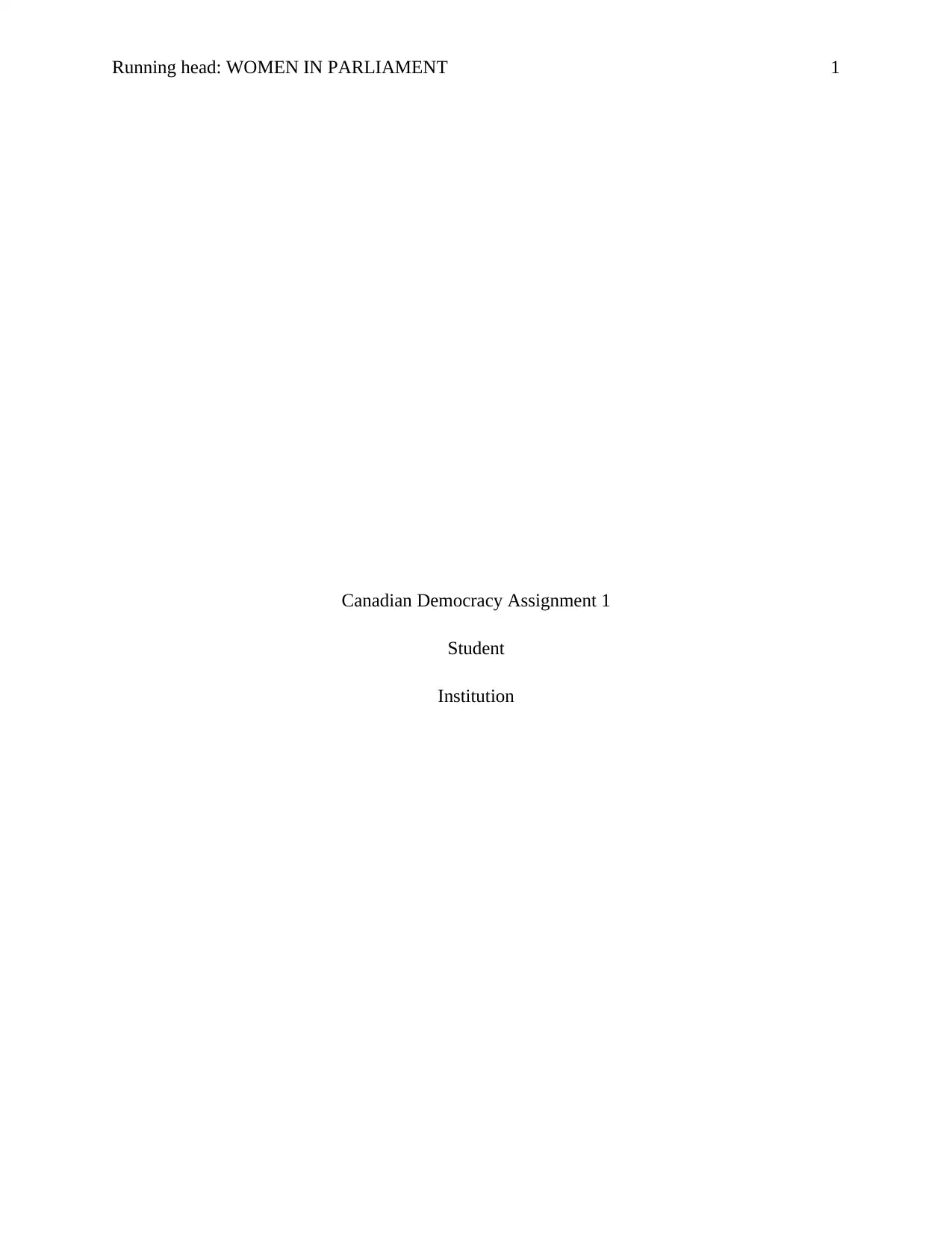
Running head: WOMEN IN PARLIAMENT 1
Canadian Democracy Assignment 1
Student
Institution
Canadian Democracy Assignment 1
Student
Institution
Secure Best Marks with AI Grader
Need help grading? Try our AI Grader for instant feedback on your assignments.
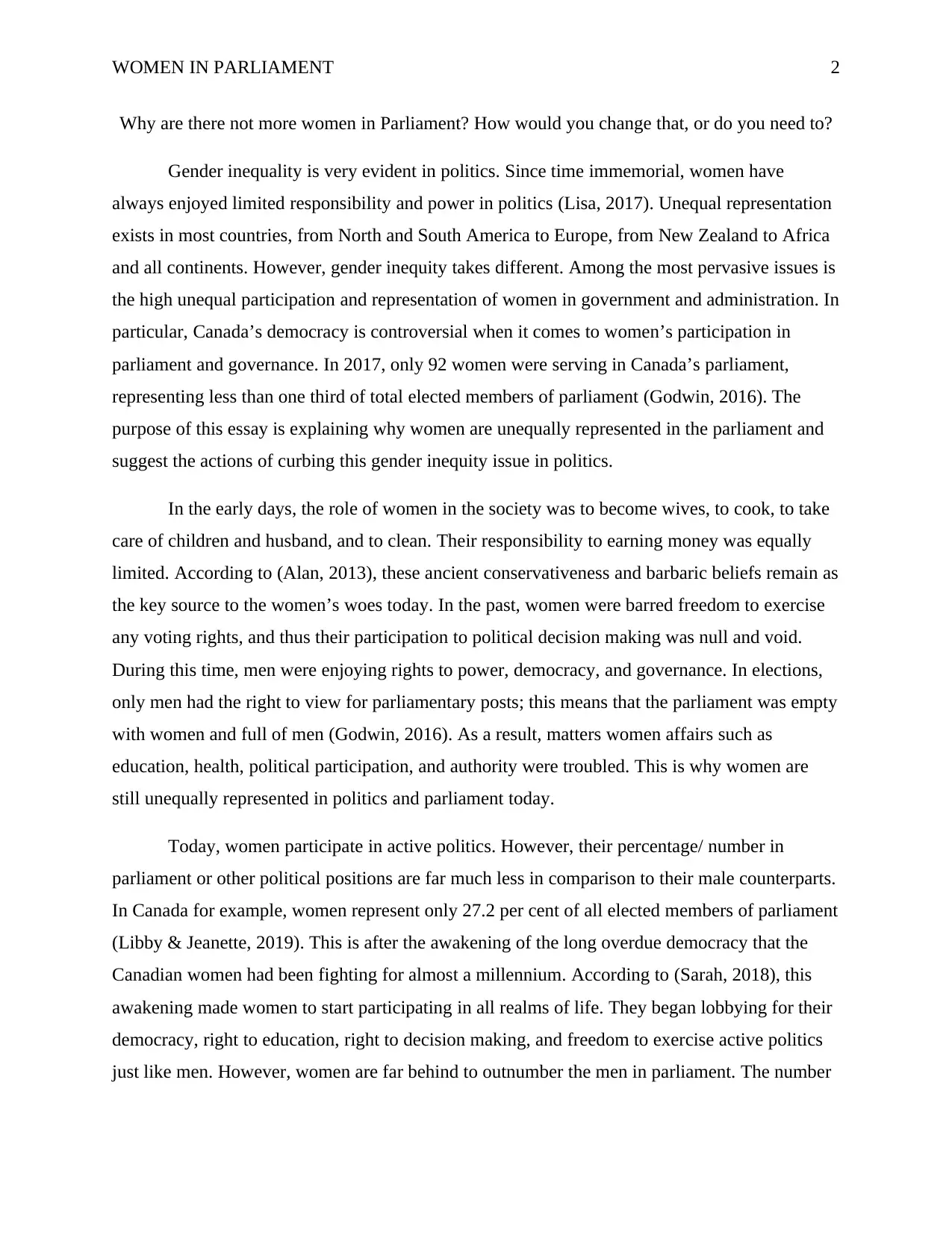
WOMEN IN PARLIAMENT 2
Why are there not more women in Parliament? How would you change that, or do you need to?
Gender inequality is very evident in politics. Since time immemorial, women have
always enjoyed limited responsibility and power in politics (Lisa, 2017). Unequal representation
exists in most countries, from North and South America to Europe, from New Zealand to Africa
and all continents. However, gender inequity takes different. Among the most pervasive issues is
the high unequal participation and representation of women in government and administration. In
particular, Canada’s democracy is controversial when it comes to women’s participation in
parliament and governance. In 2017, only 92 women were serving in Canada’s parliament,
representing less than one third of total elected members of parliament (Godwin, 2016). The
purpose of this essay is explaining why women are unequally represented in the parliament and
suggest the actions of curbing this gender inequity issue in politics.
In the early days, the role of women in the society was to become wives, to cook, to take
care of children and husband, and to clean. Their responsibility to earning money was equally
limited. According to (Alan, 2013), these ancient conservativeness and barbaric beliefs remain as
the key source to the women’s woes today. In the past, women were barred freedom to exercise
any voting rights, and thus their participation to political decision making was null and void.
During this time, men were enjoying rights to power, democracy, and governance. In elections,
only men had the right to view for parliamentary posts; this means that the parliament was empty
with women and full of men (Godwin, 2016). As a result, matters women affairs such as
education, health, political participation, and authority were troubled. This is why women are
still unequally represented in politics and parliament today.
Today, women participate in active politics. However, their percentage/ number in
parliament or other political positions are far much less in comparison to their male counterparts.
In Canada for example, women represent only 27.2 per cent of all elected members of parliament
(Libby & Jeanette, 2019). This is after the awakening of the long overdue democracy that the
Canadian women had been fighting for almost a millennium. According to (Sarah, 2018), this
awakening made women to start participating in all realms of life. They began lobbying for their
democracy, right to education, right to decision making, and freedom to exercise active politics
just like men. However, women are far behind to outnumber the men in parliament. The number
Why are there not more women in Parliament? How would you change that, or do you need to?
Gender inequality is very evident in politics. Since time immemorial, women have
always enjoyed limited responsibility and power in politics (Lisa, 2017). Unequal representation
exists in most countries, from North and South America to Europe, from New Zealand to Africa
and all continents. However, gender inequity takes different. Among the most pervasive issues is
the high unequal participation and representation of women in government and administration. In
particular, Canada’s democracy is controversial when it comes to women’s participation in
parliament and governance. In 2017, only 92 women were serving in Canada’s parliament,
representing less than one third of total elected members of parliament (Godwin, 2016). The
purpose of this essay is explaining why women are unequally represented in the parliament and
suggest the actions of curbing this gender inequity issue in politics.
In the early days, the role of women in the society was to become wives, to cook, to take
care of children and husband, and to clean. Their responsibility to earning money was equally
limited. According to (Alan, 2013), these ancient conservativeness and barbaric beliefs remain as
the key source to the women’s woes today. In the past, women were barred freedom to exercise
any voting rights, and thus their participation to political decision making was null and void.
During this time, men were enjoying rights to power, democracy, and governance. In elections,
only men had the right to view for parliamentary posts; this means that the parliament was empty
with women and full of men (Godwin, 2016). As a result, matters women affairs such as
education, health, political participation, and authority were troubled. This is why women are
still unequally represented in politics and parliament today.
Today, women participate in active politics. However, their percentage/ number in
parliament or other political positions are far much less in comparison to their male counterparts.
In Canada for example, women represent only 27.2 per cent of all elected members of parliament
(Libby & Jeanette, 2019). This is after the awakening of the long overdue democracy that the
Canadian women had been fighting for almost a millennium. According to (Sarah, 2018), this
awakening made women to start participating in all realms of life. They began lobbying for their
democracy, right to education, right to decision making, and freedom to exercise active politics
just like men. However, women are far behind to outnumber the men in parliament. The number
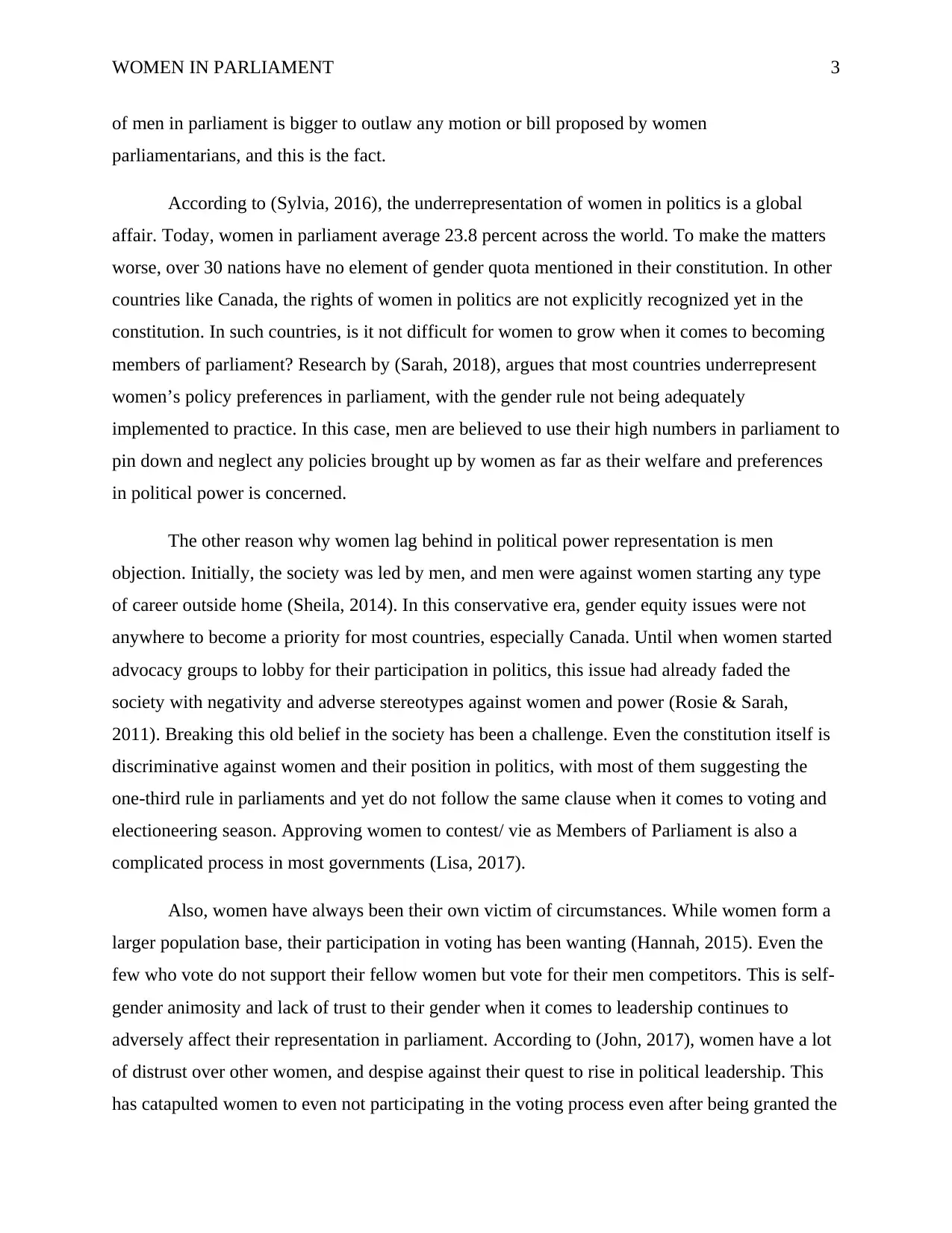
WOMEN IN PARLIAMENT 3
of men in parliament is bigger to outlaw any motion or bill proposed by women
parliamentarians, and this is the fact.
According to (Sylvia, 2016), the underrepresentation of women in politics is a global
affair. Today, women in parliament average 23.8 percent across the world. To make the matters
worse, over 30 nations have no element of gender quota mentioned in their constitution. In other
countries like Canada, the rights of women in politics are not explicitly recognized yet in the
constitution. In such countries, is it not difficult for women to grow when it comes to becoming
members of parliament? Research by (Sarah, 2018), argues that most countries underrepresent
women’s policy preferences in parliament, with the gender rule not being adequately
implemented to practice. In this case, men are believed to use their high numbers in parliament to
pin down and neglect any policies brought up by women as far as their welfare and preferences
in political power is concerned.
The other reason why women lag behind in political power representation is men
objection. Initially, the society was led by men, and men were against women starting any type
of career outside home (Sheila, 2014). In this conservative era, gender equity issues were not
anywhere to become a priority for most countries, especially Canada. Until when women started
advocacy groups to lobby for their participation in politics, this issue had already faded the
society with negativity and adverse stereotypes against women and power (Rosie & Sarah,
2011). Breaking this old belief in the society has been a challenge. Even the constitution itself is
discriminative against women and their position in politics, with most of them suggesting the
one-third rule in parliaments and yet do not follow the same clause when it comes to voting and
electioneering season. Approving women to contest/ vie as Members of Parliament is also a
complicated process in most governments (Lisa, 2017).
Also, women have always been their own victim of circumstances. While women form a
larger population base, their participation in voting has been wanting (Hannah, 2015). Even the
few who vote do not support their fellow women but vote for their men competitors. This is self-
gender animosity and lack of trust to their gender when it comes to leadership continues to
adversely affect their representation in parliament. According to (John, 2017), women have a lot
of distrust over other women, and despise against their quest to rise in political leadership. This
has catapulted women to even not participating in the voting process even after being granted the
of men in parliament is bigger to outlaw any motion or bill proposed by women
parliamentarians, and this is the fact.
According to (Sylvia, 2016), the underrepresentation of women in politics is a global
affair. Today, women in parliament average 23.8 percent across the world. To make the matters
worse, over 30 nations have no element of gender quota mentioned in their constitution. In other
countries like Canada, the rights of women in politics are not explicitly recognized yet in the
constitution. In such countries, is it not difficult for women to grow when it comes to becoming
members of parliament? Research by (Sarah, 2018), argues that most countries underrepresent
women’s policy preferences in parliament, with the gender rule not being adequately
implemented to practice. In this case, men are believed to use their high numbers in parliament to
pin down and neglect any policies brought up by women as far as their welfare and preferences
in political power is concerned.
The other reason why women lag behind in political power representation is men
objection. Initially, the society was led by men, and men were against women starting any type
of career outside home (Sheila, 2014). In this conservative era, gender equity issues were not
anywhere to become a priority for most countries, especially Canada. Until when women started
advocacy groups to lobby for their participation in politics, this issue had already faded the
society with negativity and adverse stereotypes against women and power (Rosie & Sarah,
2011). Breaking this old belief in the society has been a challenge. Even the constitution itself is
discriminative against women and their position in politics, with most of them suggesting the
one-third rule in parliaments and yet do not follow the same clause when it comes to voting and
electioneering season. Approving women to contest/ vie as Members of Parliament is also a
complicated process in most governments (Lisa, 2017).
Also, women have always been their own victim of circumstances. While women form a
larger population base, their participation in voting has been wanting (Hannah, 2015). Even the
few who vote do not support their fellow women but vote for their men competitors. This is self-
gender animosity and lack of trust to their gender when it comes to leadership continues to
adversely affect their representation in parliament. According to (John, 2017), women have a lot
of distrust over other women, and despise against their quest to rise in political leadership. This
has catapulted women to even not participating in the voting process even after being granted the
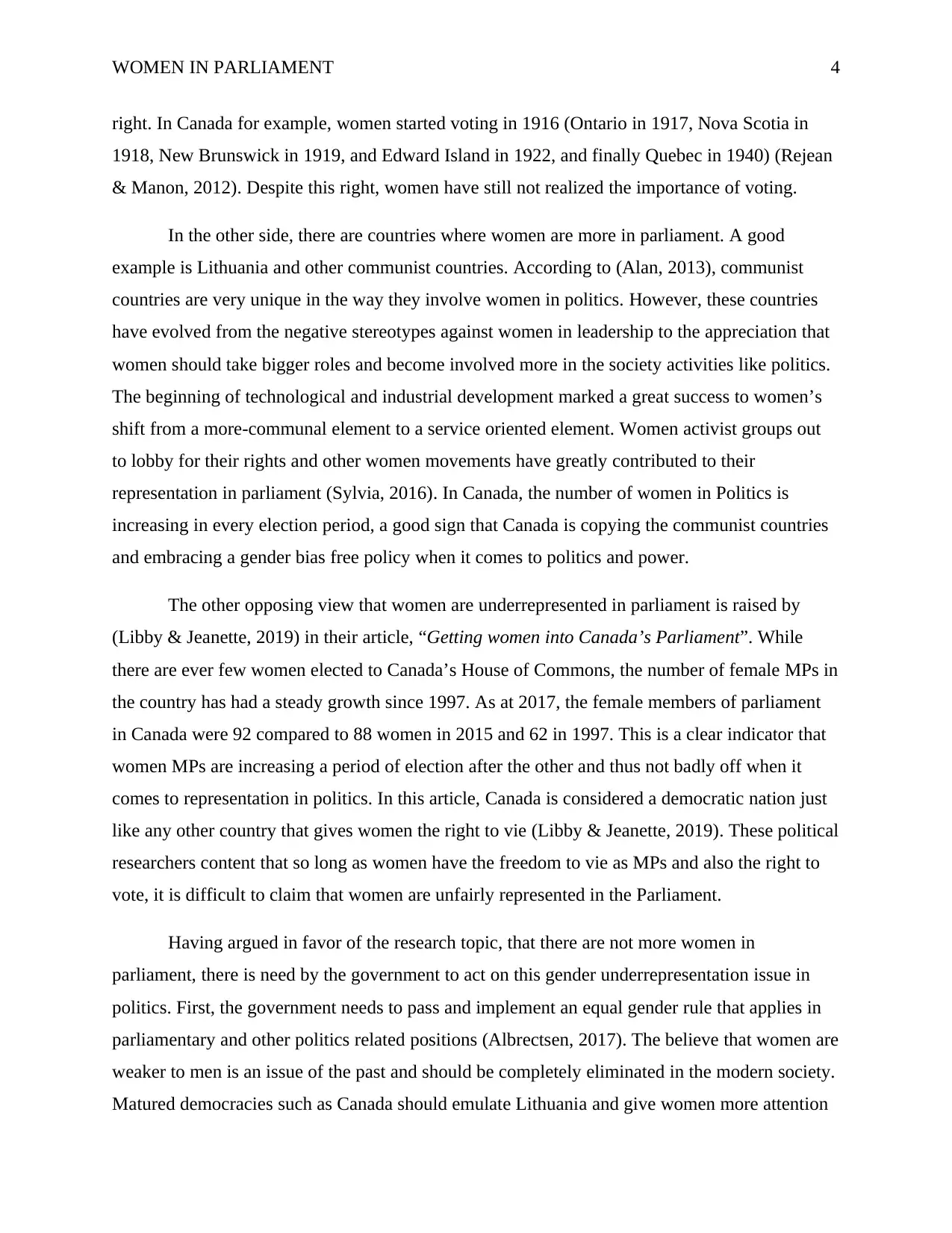
WOMEN IN PARLIAMENT 4
right. In Canada for example, women started voting in 1916 (Ontario in 1917, Nova Scotia in
1918, New Brunswick in 1919, and Edward Island in 1922, and finally Quebec in 1940) (Rejean
& Manon, 2012). Despite this right, women have still not realized the importance of voting.
In the other side, there are countries where women are more in parliament. A good
example is Lithuania and other communist countries. According to (Alan, 2013), communist
countries are very unique in the way they involve women in politics. However, these countries
have evolved from the negative stereotypes against women in leadership to the appreciation that
women should take bigger roles and become involved more in the society activities like politics.
The beginning of technological and industrial development marked a great success to women’s
shift from a more-communal element to a service oriented element. Women activist groups out
to lobby for their rights and other women movements have greatly contributed to their
representation in parliament (Sylvia, 2016). In Canada, the number of women in Politics is
increasing in every election period, a good sign that Canada is copying the communist countries
and embracing a gender bias free policy when it comes to politics and power.
The other opposing view that women are underrepresented in parliament is raised by
(Libby & Jeanette, 2019) in their article, “Getting women into Canada’s Parliament”. While
there are ever few women elected to Canada’s House of Commons, the number of female MPs in
the country has had a steady growth since 1997. As at 2017, the female members of parliament
in Canada were 92 compared to 88 women in 2015 and 62 in 1997. This is a clear indicator that
women MPs are increasing a period of election after the other and thus not badly off when it
comes to representation in politics. In this article, Canada is considered a democratic nation just
like any other country that gives women the right to vie (Libby & Jeanette, 2019). These political
researchers content that so long as women have the freedom to vie as MPs and also the right to
vote, it is difficult to claim that women are unfairly represented in the Parliament.
Having argued in favor of the research topic, that there are not more women in
parliament, there is need by the government to act on this gender underrepresentation issue in
politics. First, the government needs to pass and implement an equal gender rule that applies in
parliamentary and other politics related positions (Albrectsen, 2017). The believe that women are
weaker to men is an issue of the past and should be completely eliminated in the modern society.
Matured democracies such as Canada should emulate Lithuania and give women more attention
right. In Canada for example, women started voting in 1916 (Ontario in 1917, Nova Scotia in
1918, New Brunswick in 1919, and Edward Island in 1922, and finally Quebec in 1940) (Rejean
& Manon, 2012). Despite this right, women have still not realized the importance of voting.
In the other side, there are countries where women are more in parliament. A good
example is Lithuania and other communist countries. According to (Alan, 2013), communist
countries are very unique in the way they involve women in politics. However, these countries
have evolved from the negative stereotypes against women in leadership to the appreciation that
women should take bigger roles and become involved more in the society activities like politics.
The beginning of technological and industrial development marked a great success to women’s
shift from a more-communal element to a service oriented element. Women activist groups out
to lobby for their rights and other women movements have greatly contributed to their
representation in parliament (Sylvia, 2016). In Canada, the number of women in Politics is
increasing in every election period, a good sign that Canada is copying the communist countries
and embracing a gender bias free policy when it comes to politics and power.
The other opposing view that women are underrepresented in parliament is raised by
(Libby & Jeanette, 2019) in their article, “Getting women into Canada’s Parliament”. While
there are ever few women elected to Canada’s House of Commons, the number of female MPs in
the country has had a steady growth since 1997. As at 2017, the female members of parliament
in Canada were 92 compared to 88 women in 2015 and 62 in 1997. This is a clear indicator that
women MPs are increasing a period of election after the other and thus not badly off when it
comes to representation in politics. In this article, Canada is considered a democratic nation just
like any other country that gives women the right to vie (Libby & Jeanette, 2019). These political
researchers content that so long as women have the freedom to vie as MPs and also the right to
vote, it is difficult to claim that women are unfairly represented in the Parliament.
Having argued in favor of the research topic, that there are not more women in
parliament, there is need by the government to act on this gender underrepresentation issue in
politics. First, the government needs to pass and implement an equal gender rule that applies in
parliamentary and other politics related positions (Albrectsen, 2017). The believe that women are
weaker to men is an issue of the past and should be completely eliminated in the modern society.
Matured democracies such as Canada should emulate Lithuania and give women more attention
Secure Best Marks with AI Grader
Need help grading? Try our AI Grader for instant feedback on your assignments.
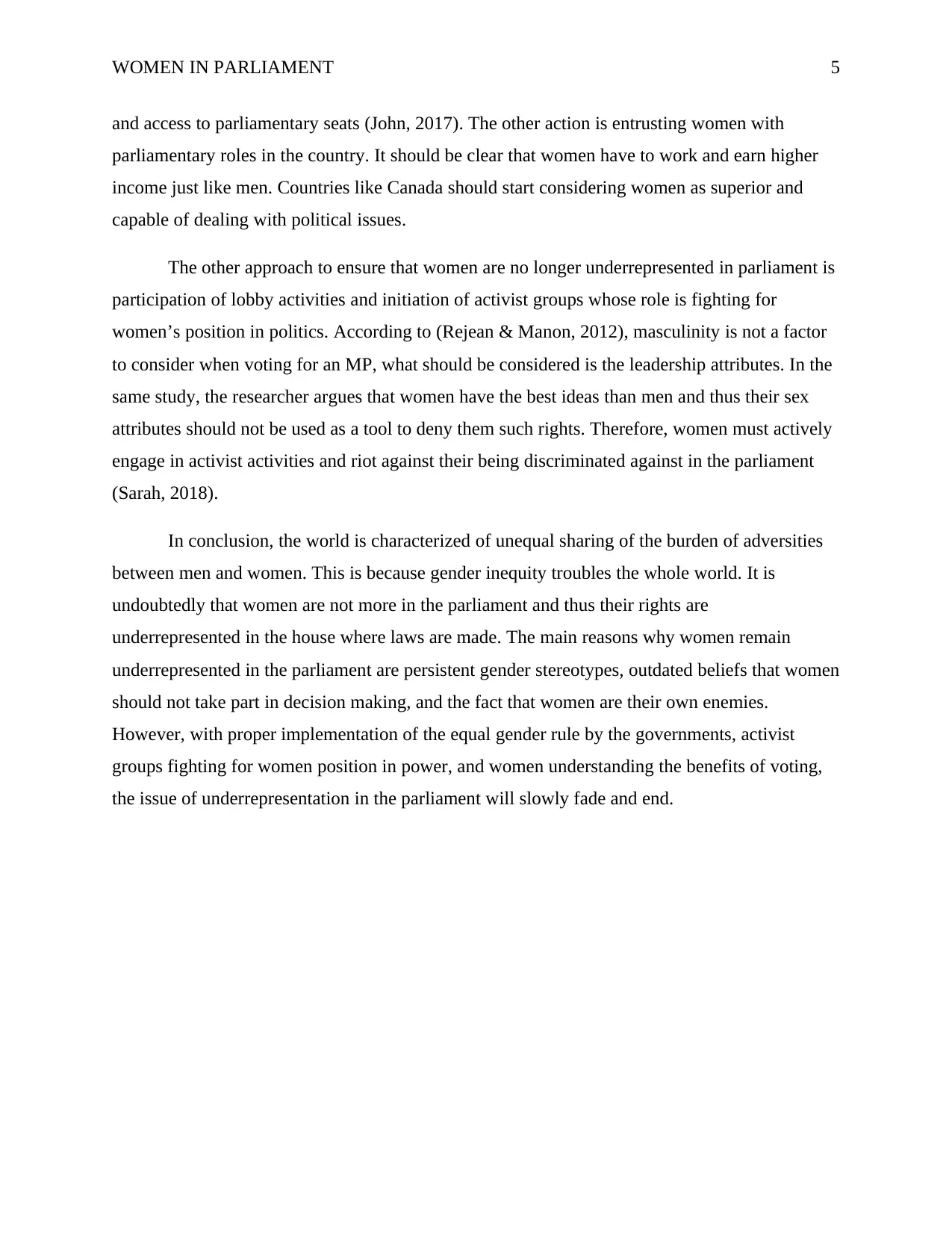
WOMEN IN PARLIAMENT 5
and access to parliamentary seats (John, 2017). The other action is entrusting women with
parliamentary roles in the country. It should be clear that women have to work and earn higher
income just like men. Countries like Canada should start considering women as superior and
capable of dealing with political issues.
The other approach to ensure that women are no longer underrepresented in parliament is
participation of lobby activities and initiation of activist groups whose role is fighting for
women’s position in politics. According to (Rejean & Manon, 2012), masculinity is not a factor
to consider when voting for an MP, what should be considered is the leadership attributes. In the
same study, the researcher argues that women have the best ideas than men and thus their sex
attributes should not be used as a tool to deny them such rights. Therefore, women must actively
engage in activist activities and riot against their being discriminated against in the parliament
(Sarah, 2018).
In conclusion, the world is characterized of unequal sharing of the burden of adversities
between men and women. This is because gender inequity troubles the whole world. It is
undoubtedly that women are not more in the parliament and thus their rights are
underrepresented in the house where laws are made. The main reasons why women remain
underrepresented in the parliament are persistent gender stereotypes, outdated beliefs that women
should not take part in decision making, and the fact that women are their own enemies.
However, with proper implementation of the equal gender rule by the governments, activist
groups fighting for women position in power, and women understanding the benefits of voting,
the issue of underrepresentation in the parliament will slowly fade and end.
and access to parliamentary seats (John, 2017). The other action is entrusting women with
parliamentary roles in the country. It should be clear that women have to work and earn higher
income just like men. Countries like Canada should start considering women as superior and
capable of dealing with political issues.
The other approach to ensure that women are no longer underrepresented in parliament is
participation of lobby activities and initiation of activist groups whose role is fighting for
women’s position in politics. According to (Rejean & Manon, 2012), masculinity is not a factor
to consider when voting for an MP, what should be considered is the leadership attributes. In the
same study, the researcher argues that women have the best ideas than men and thus their sex
attributes should not be used as a tool to deny them such rights. Therefore, women must actively
engage in activist activities and riot against their being discriminated against in the parliament
(Sarah, 2018).
In conclusion, the world is characterized of unequal sharing of the burden of adversities
between men and women. This is because gender inequity troubles the whole world. It is
undoubtedly that women are not more in the parliament and thus their rights are
underrepresented in the house where laws are made. The main reasons why women remain
underrepresented in the parliament are persistent gender stereotypes, outdated beliefs that women
should not take part in decision making, and the fact that women are their own enemies.
However, with proper implementation of the equal gender rule by the governments, activist
groups fighting for women position in power, and women understanding the benefits of voting,
the issue of underrepresentation in the parliament will slowly fade and end.
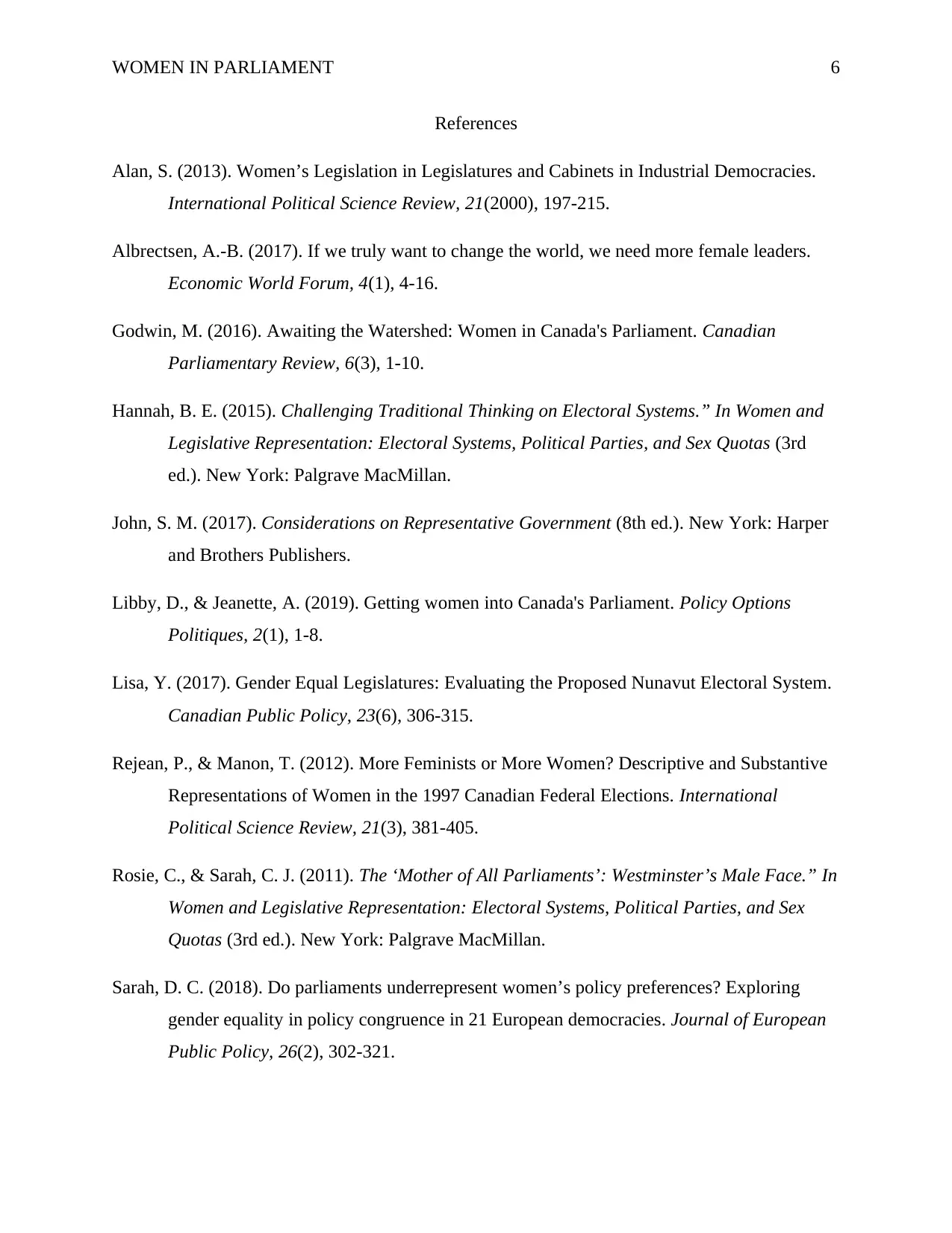
WOMEN IN PARLIAMENT 6
References
Alan, S. (2013). Women’s Legislation in Legislatures and Cabinets in Industrial Democracies.
International Political Science Review, 21(2000), 197-215.
Albrectsen, A.-B. (2017). If we truly want to change the world, we need more female leaders.
Economic World Forum, 4(1), 4-16.
Godwin, M. (2016). Awaiting the Watershed: Women in Canada's Parliament. Canadian
Parliamentary Review, 6(3), 1-10.
Hannah, B. E. (2015). Challenging Traditional Thinking on Electoral Systems.” In Women and
Legislative Representation: Electoral Systems, Political Parties, and Sex Quotas (3rd
ed.). New York: Palgrave MacMillan.
John, S. M. (2017). Considerations on Representative Government (8th ed.). New York: Harper
and Brothers Publishers.
Libby, D., & Jeanette, A. (2019). Getting women into Canada's Parliament. Policy Options
Politiques, 2(1), 1-8.
Lisa, Y. (2017). Gender Equal Legislatures: Evaluating the Proposed Nunavut Electoral System.
Canadian Public Policy, 23(6), 306-315.
Rejean, P., & Manon, T. (2012). More Feminists or More Women? Descriptive and Substantive
Representations of Women in the 1997 Canadian Federal Elections. International
Political Science Review, 21(3), 381-405.
Rosie, C., & Sarah, C. J. (2011). The ‘Mother of All Parliaments’: Westminster’s Male Face.” In
Women and Legislative Representation: Electoral Systems, Political Parties, and Sex
Quotas (3rd ed.). New York: Palgrave MacMillan.
Sarah, D. C. (2018). Do parliaments underrepresent women’s policy preferences? Exploring
gender equality in policy congruence in 21 European democracies. Journal of European
Public Policy, 26(2), 302-321.
References
Alan, S. (2013). Women’s Legislation in Legislatures and Cabinets in Industrial Democracies.
International Political Science Review, 21(2000), 197-215.
Albrectsen, A.-B. (2017). If we truly want to change the world, we need more female leaders.
Economic World Forum, 4(1), 4-16.
Godwin, M. (2016). Awaiting the Watershed: Women in Canada's Parliament. Canadian
Parliamentary Review, 6(3), 1-10.
Hannah, B. E. (2015). Challenging Traditional Thinking on Electoral Systems.” In Women and
Legislative Representation: Electoral Systems, Political Parties, and Sex Quotas (3rd
ed.). New York: Palgrave MacMillan.
John, S. M. (2017). Considerations on Representative Government (8th ed.). New York: Harper
and Brothers Publishers.
Libby, D., & Jeanette, A. (2019). Getting women into Canada's Parliament. Policy Options
Politiques, 2(1), 1-8.
Lisa, Y. (2017). Gender Equal Legislatures: Evaluating the Proposed Nunavut Electoral System.
Canadian Public Policy, 23(6), 306-315.
Rejean, P., & Manon, T. (2012). More Feminists or More Women? Descriptive and Substantive
Representations of Women in the 1997 Canadian Federal Elections. International
Political Science Review, 21(3), 381-405.
Rosie, C., & Sarah, C. J. (2011). The ‘Mother of All Parliaments’: Westminster’s Male Face.” In
Women and Legislative Representation: Electoral Systems, Political Parties, and Sex
Quotas (3rd ed.). New York: Palgrave MacMillan.
Sarah, D. C. (2018). Do parliaments underrepresent women’s policy preferences? Exploring
gender equality in policy congruence in 21 European democracies. Journal of European
Public Policy, 26(2), 302-321.
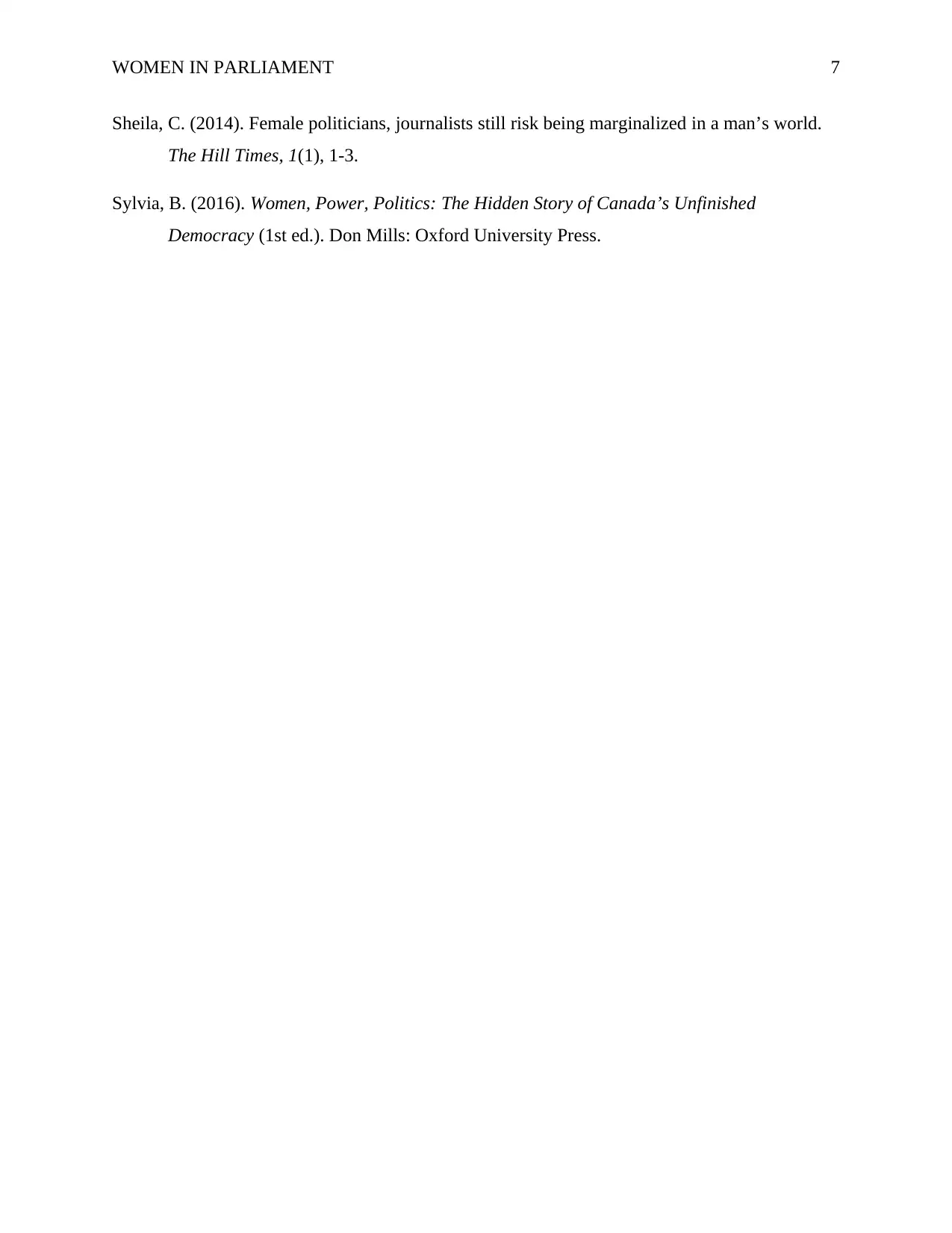
WOMEN IN PARLIAMENT 7
Sheila, C. (2014). Female politicians, journalists still risk being marginalized in a man’s world.
The Hill Times, 1(1), 1-3.
Sylvia, B. (2016). Women, Power, Politics: The Hidden Story of Canada’s Unfinished
Democracy (1st ed.). Don Mills: Oxford University Press.
Sheila, C. (2014). Female politicians, journalists still risk being marginalized in a man’s world.
The Hill Times, 1(1), 1-3.
Sylvia, B. (2016). Women, Power, Politics: The Hidden Story of Canada’s Unfinished
Democracy (1st ed.). Don Mills: Oxford University Press.
1 out of 7
Your All-in-One AI-Powered Toolkit for Academic Success.
+13062052269
info@desklib.com
Available 24*7 on WhatsApp / Email
![[object Object]](/_next/static/media/star-bottom.7253800d.svg)
Unlock your academic potential
© 2024 | Zucol Services PVT LTD | All rights reserved.


